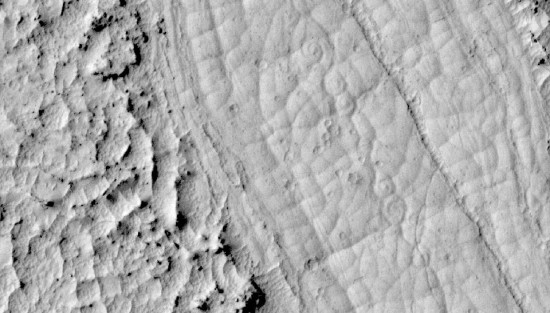Jul 07, 2014
So-called “lava coils” are present on Mars.
“Ares…who whirl your fiery sphere among the planets in their sevenfold courses through the aether wherein your blazing steeds ever bear you above the third firmament of heaven…”
— Homer, Hymn 8 to Ares (exert)
A previous Picture of the Day discussed the logarithmic spiral that dominates the northern hemisphere of Saturn’s moon, Phoebe. Phoebe was the first moon encountered by the Cassini spacecraft as it began to explore the icy bodies in orbit around Saturn. Due to its trajectory, however, Cassini was never able to return to Phoebe for more data. The few images that were sent to Earth are the only ones available.
The spiral on Phoebe is an example of how various phenomena exhibit physical evidence of the Fibonacci sequence. Leonardo Pisano Bigollo, also known as Leonardo Fibonacci, was an Italian mathematician who lived from about 1170 to 1240; the precise dates are indeterminate. In his book, Liber Abaci, Fibonacci described a series of numbers, where the first two are ones and every number thereafter is the sum of the two previous numbers: 1+1=2, 2+1=3, 3+2=5, 5+3=8, 8+5=13, 13+8=21, etc. When those numbers are plotted, a logarithmic spiral is generated.
Such spirals are common in nature. From flowers like the rose and sunflower, to plants like aloe vera, the Fibonacci sequence is displayed. The animal kingdom also reveals logarithmic spirals: the chambered nautilus shell, for instance, grows into a spiral as it matures. Of course, at the largest observable scale, galaxies, like M74 (NGC 628), exhibit a characteristic logarithmic spiral. Perhaps the Universe itself unfolds according to the Fibonacci sequence.
Recently, a University of Arizona press release announced that spiral formations occur on Mars in what are deemed to be lava flows. The structures are said to resemble “lava coils” on Earth, which develop when thin lava flows pass by each other. The fluid dynamic interaction causes it to create a whirlpool-like pattern that hardens into a helical shape.
A major problem with the Earth-like lava coil theory is that they look nothing like the spirals seen on Mars. The shapes on Mars appear to follow the Fibonacci sequence, while those on Earth do not. The Martian spirals are cut into the surface, as well, where the volcanic coils are solidified above the substrate. Martian spirals are also orders of magnitude larger than those on Earth. What accounts for the differences?
First, the spiral-shaped figures on Mars are not the result of vulcanism: there are no volcanoes near Cerberus Palus that could contribute the lava flows. Second, the spirals are part of other trench-like rilles in the region. Athabasca Valles, of which Cerberus Palus is a part, shows signs of intense electrical discharge effects. There are deep chasms, known as “fosse” that cut through the surface. They are steep-sided, flat-bottomed canyons with no inlets or outlets. They begin and end suddenly. Lacking any other context, planetary scientists say that they were cut by water, or that they are collapsed lava tubes—it depends on which scientist answers the question. However, the fulgurites embedded in their sidewalls identify them as electrical excavations.
There are other spiral-shaped structures on Mars. There are mountains in some locations that embody spirals ascending up their sides. There are also several craters that spiral around toward their central depressions. In some cases, the spirals terminate in elevated, stacked terraces instead of depressions. How does a meteor impact leave behind stacked terraces?
A probable explanation for the so-called lava coils on Mars is that they are examples of the Rosensweig Instability, a theory about the activity of perpendicular magnetic fields on ferromagnetic substances. For more information, see the Electric Universe 2014 presentation: Mars the Great Desert in 3D. Rosensweig instabilities create spiral formations, so it might be that those in Cerberus Palus illustrate the idea.
Stephen Smith













